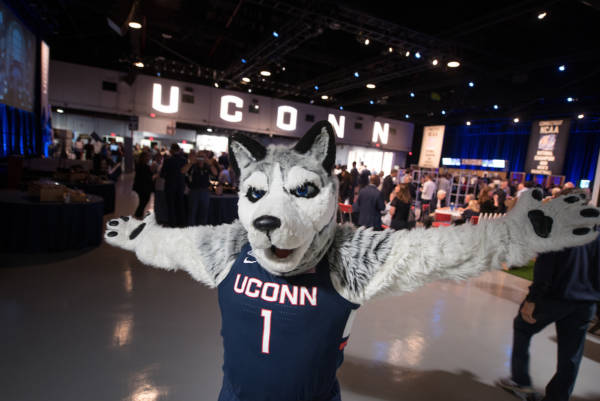UConn Alum Slides to Olympic Bronze in Bobsled
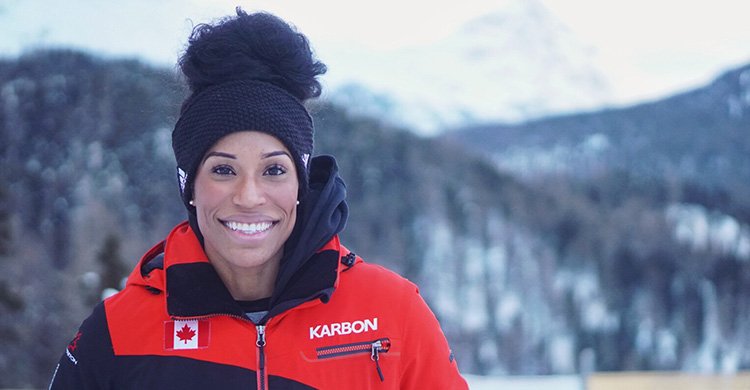
UConn alum Phylicia George won the bronze medal in women’s bobsled at the Winter Olympics in Pyeongchang.
George, a hurdler in the Summer Olympics, and teammate Kaillie Humphries came in third in the two-woman bobsled Wednesday, representing Canada in the Olympics. Germany won gold and the United States took silver.
Believe it or not, George ’10 (CLAS) had never even been on a bobsled until about 15 months ago. But this is actually her third Olympics. A premier sprint hurdler from Markham, Ontario, Canada, she competed in the 2012 London and 2016 Rio Games and hopes to do it again at the 2020 Summer Olympics in Toyko. Because of her speed and strength, she was recruited to be the brakeman in the two-woman bobsled with Humphries, a two-time bobsled gold medalist.
This is perhaps not surprising to her UConn teammates who remember her prowess as a track and field star. She excelled off the field at UConn as well, majoring in biology and minoring in physiology and neurobiology. We caught up with George recently in PyeongChang and talked to her about becoming a bobsledder and how UConn helped shape her drive and mental toughness.
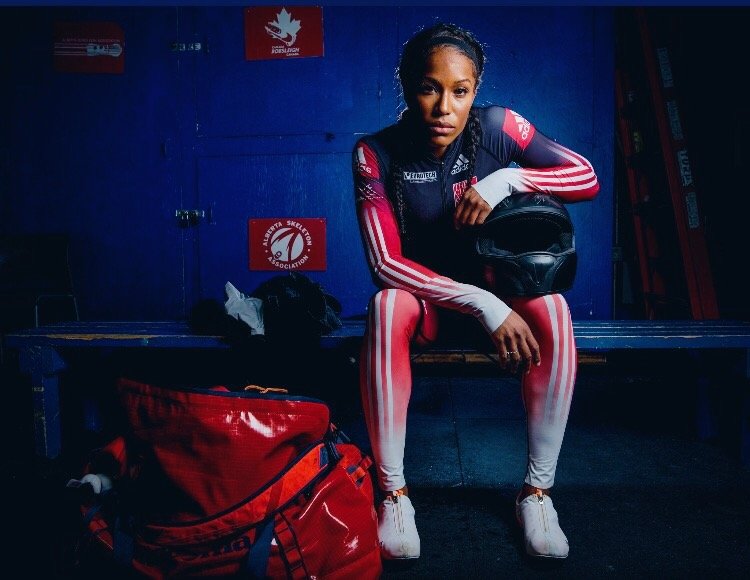
You’re a two-time Olympian. That’s amazing. And you just started doing the bobsled, right? How did that happen?
This is my third Olympic Games. I competed in the London and Rio Olympics in the 100-meter hurdles, where I was an Olympic finalist in both. In terms of bobsled, Kaillie Humphries, my current race teammate, contacted me, after the Rio Olympics in search of a new brakeman to race with for PyeongChang. She and her coach, Stu McMillian, (and now my bobsled coach) saw a lot of potential in me and saw the benefit of having an experienced athlete team up with Kaillie. The idea of potentially becoming a summer and winter Olympian sparked my interest. I relish any opportunity to compete for my country. I knew it would be challenging to start a new sport and attempt to qualify for the Olympics but I was up for the challenge. I agreed to come out and try going down the bobsled track before I made a final decision. While it was a bit of a shock to my system, I enjoyed the thrill of it and the challenge of seeing myself get better at the sport. I took two weeks off after the 2017 London Track and Field World Championship, and then I began fulltime bobsled training for the winter.
Are there any similarities between the two sports?
There are some similarities but also a lot of differences. I’d say the main similarity is the fact that running is involved and being fast is a huge advantage. But it’s very different in the way that you run and create force. I had to get used to not swinging my hands while running and learning how to use my hands to transfer the force I was creating with my feet into the sled. In essence, I had to learn to push the sled and accelerate it, instead of simply running behind it.
What is your job on the bobsled? What do you do?
I’m the push athlete; I sit behind the pilot. My job is to get the sled moving as fast as possible at the start. Bobsled is a sport that is won in hundredths of second, so the start is essential to ensuring the run is fast. Then at the end of the track, I pull the brakes.
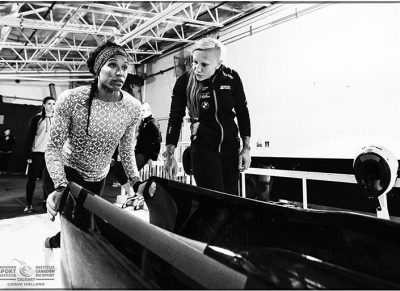 What is the scariest part of doing the bobsled?
What is the scariest part of doing the bobsled?
It takes time getting used to being in the bobsled. You’re moving at speed up to 99mph and there are g-forces pressing down on your body. My first time in a bobsled was in Whistler, British Columbia, which is the fastest track, with some of the most g-forces of any bobsled track. I wasn’t sitting in an optimal position. I was sitting up way too high, and, as a result, I felt those forces much more excessively. However, I had decided beforehand that I would take two runs that day. Thankfully, I stuck with it, because my second run felt better. And every run I’ve done since has gotten better and better and I’ve become much more comfortable with the speeds and forces. I’ve had many people ask me what it’s like being in a bobsled, but it truly is its own unique experience, which makes it hard to describe unless you’ve personally experienced it.
Have you always been a thrill seeker?
I wouldn’t say I’m a thrill seeker, but I believe in stepping outside of your comfort zone to constantly challenge yourself. That’s the way I’ve looked at this journey through bobsled. At times it’s been scary and uncomfortable, but I’ve used it all to challenge myself to be the best athlete I can be.
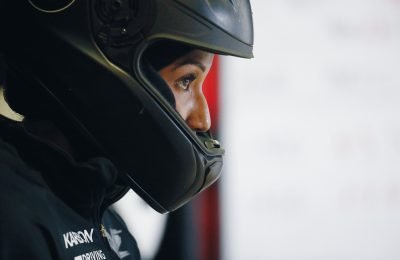
Have you had any crashes?
I’ve thankfully only had one crash. It was in Lake Placid, New York. It was near the end of the run; we had about two more turns to go and flipped onto our side. In a crash, you still travel down the track, so we basically were sliding through two turns with our helmets and shoulders on the ice. The main thing I remember is just how loud it was hearing the side of the sled and our helmets on the ice. Thankfully, I had no injuries and was totally fine after.
What’s going through your mind when you’re hurdling down the track at top speed?
I’m mainly focused on the track and the turns that we are going through, making sure I feel the turns so I know where we are. Everything happens so quickly so it’s hard to think about too much.
Did you have to build muscle weight to do the bobsled?
Getting stronger was a huge factor. I had to start lifting much heavier than I do for track and field. I gained 12 pounds of lean muscle mass, added three inches to my bicep, one inch to my quad and five inches to my hips and glutes. Strength plays a huge role in bobsled. The sled weighs 363 pounds, so you have to be strong and powerful to get it moving and to accelerate it.
Will you go for the next Olympics? Summer? Winter? Both?
I will return to track and field in March, with the ultimate goal of continuing my preparation for 2020 Summer Olympics. I’m excited to bring my newfound strength and power back to the track. I’m unsure of whether I will compete past 2020.
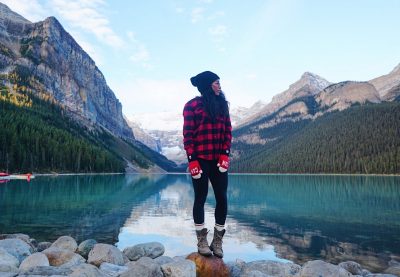
What do you do when you’re not training?
I’m an avid reader, so I’m usually reading or watching a TV series to kill time. I also love to travel.
Do you have a job?
I am a full-time athlete.
Can you tell me about your family? Hobbies?
My father is a middle school guidance counselor, who always stressed the importance of education to me. My mother, Glenna, passed away when I was in my senior year at UConn, but she was always one of my biggest supporters, and one of my goals is to always make her proud. I have a twin brother who is a computer programmer, as well as three older sisters, two of whom are teachers and the other is a pharmacist.
How has UConn helped you on your journey?
UConn played a huge role in my development as an athlete and as a person. My coach, Clive Terrelonge, helped to lay the foundation and gave me some of the tools for my future success. He truly helped me to become a mentally strong athlete. He saw potential in me that I didn’t even know existed and his belief helped me push my boundaries and to believe in myself and my abilities. I had the opportunity to train alongside some talented athletes that I was fortunate enough to call teammates, and we all pushed each other to become better athletes. While studying for my degree in biology, I gained extensive knowledge, many life skills as well made some life-long friendships.
